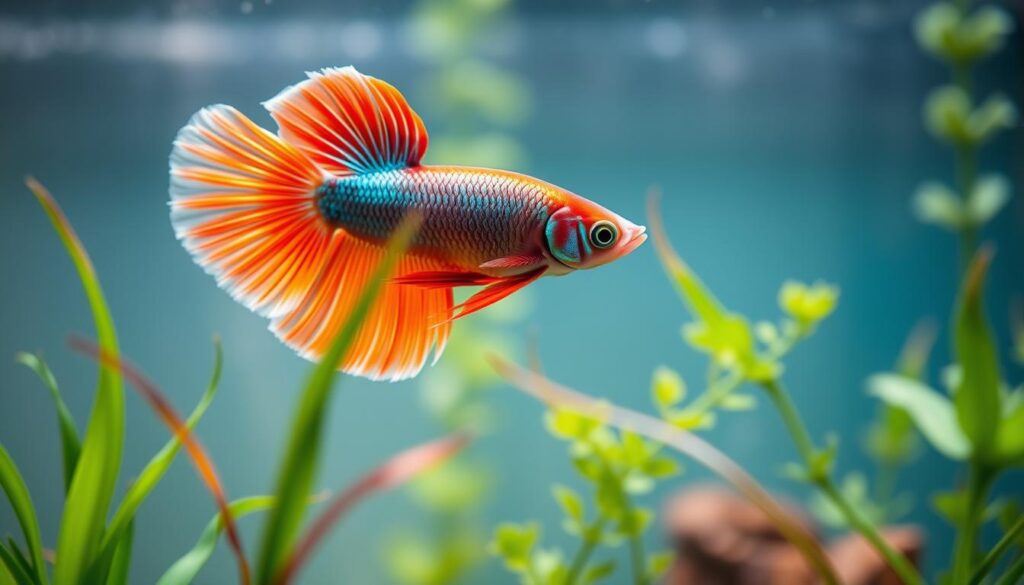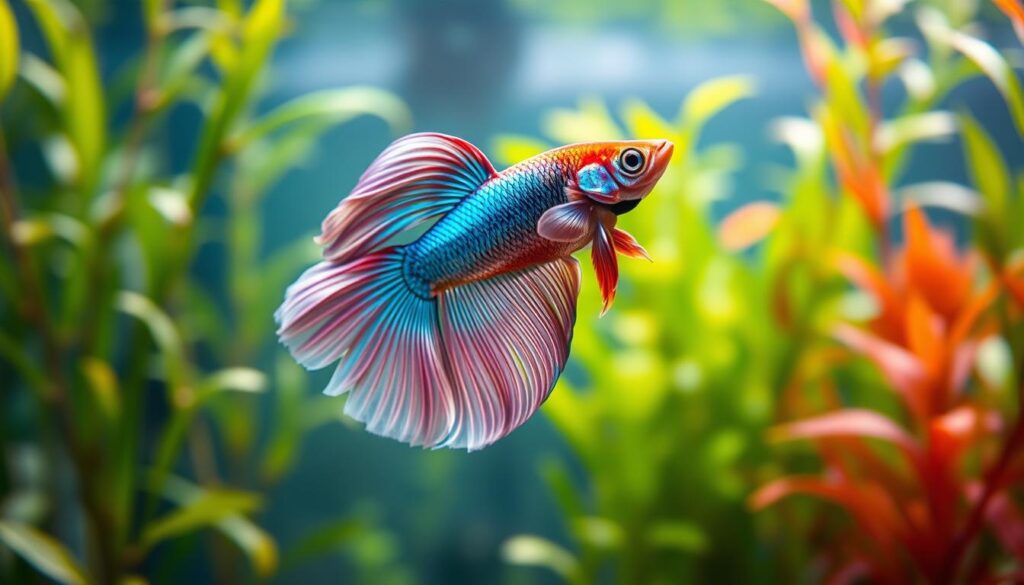Is your Betta fish swimming sideways, floating awkwardly, or sinking to the bottom of the tank? These are classic signs of a condition many fish owners face—swim bladder disease. But the big question is: how to cure Betta fish swim bladder disease effectively and safely?
This common illness affects your Betta’s ability to control its buoyancy and swim normally. It’s usually caused by overfeeding, constipation, poor water quality, or sudden temperature changes.
In this guide, we’ll walk you through how to cure Betta fish swim bladder disease, covering symptoms, quick remedies, and long-term prevention tips to keep your Betta healthy and happy.
We’re here to guide you through the causes, signs, and treatment options. With the right care, you can help your betta fish get better quickly!
Key Takeaways
- Understand the causes and symptoms of swim bladder disease in betta fish.
- Learn effective treatment options for betta fish swim bladder disease.
- Discover how to prevent swim bladder disease in your betta fish.
- Get tips on providing proper care and nutrition for your betta fish.
- Find out when to seek professional help for your betta fish’s swim bladder issues.
Understanding Swim Bladder Disease in Betta Fish
Swim bladder disease might sound scary, but learning about it can help your betta. Let’s explore what it is and how it affects your betta fish.
What is the Swim Bladder and Its Function
The swim bladder is a key organ in fish that helps them stay afloat. It’s a gas-filled sac that lets betta fish swim easily at various depths. It’s like a balloon that changes size to adjust the fish’s buoyancy.
How Swim Bladder Disease Affects Your Betta
When a betta fish gets swim bladder disease, it can’t stay buoyant right. This makes your betta float oddly, sink, or swim hard. It’s tough to see, but many betta fish can get better with the right care.
| Symptoms | Description |
|---|---|
| Floating Abnormally | Betta fish may float sideways or upside down due to improper buoyancy. |
| Sinking | Some betta fish may lose their buoyancy entirely and sink to the bottom. |
| Swimming Struggles | Betta fish with swim bladder disease may struggle to swim or maintain their position in the water. |
Common Causes of Swim Bladder Disease
Swim bladder disease in betta fish can be caused by several factors. Knowing these causes is key to treating it effectively. As a betta fish owner, you want your pet to be happy and healthy. Let’s explore the common causes of this condition.
Overfeeding and Poor Diet
Overfeeding is a common mistake that can lead to swim bladder disease in betta fish. Too much food can make the stomach bloated, putting pressure on the swim bladder. A bad diet lacking essential nutrients can also cause this problem. To avoid it, feed your betta a balanced diet and don’t overfeed!
A good diet for your betta should include a variety of nutrient-rich foods. Here’s a table to help you understand what your betta needs:
| Nutrient | Importance | Food Sources |
|---|---|---|
| Protein | Essential for growth and repair | Live or frozen brine shrimp, bloodworms |
| Fiber | Helps with digestion | Vegetables like peas, zucchini |
Water Quality Issues
Water quality is crucial for your betta fish’s health. Poor water quality can stress your betta, leading to swim bladder disease. Regular water changes and keeping water parameters optimal can help prevent this. Remember, “You are what you eat,” but for betta fish, it’s more like, “You are the water you swim in!”
Experts agree that good water quality is essential for betta fish health. As one expert notes:
“Regular water changes and monitoring water parameters are key to keeping your betta fish healthy and thriving.”
Physical Injuries and Genetic Factors
Physical injuries can also cause swim bladder disease in betta fish. For example, a collision with a decoration or attack by another fish can harm the swim bladder. Some betta fish may be more prone to this disease due to genetics. While you can’t change your betta’s genetics, you can prevent physical injuries by creating a safe environment.
By understanding the common causes of swim bladder disease, you can take steps to prevent it. This ensures your betta fish lives a happy, healthy life. If you’re looking forbetta fish swim bladder remediesorbetta fish swim bladder medication, first address the underlying causes.
Recognizing the Symptoms of Swim Bladder Disease
Spotting the signs of swim bladder disease is key to helping your betta fish get better. Your betta might act differently if it’s not feeling well. Knowing these signs can help you find the right treatment.
Floating Sideways or Upside Down
One common sign is when your betta floats sideways or upside down. This usually means it can’t control its buoyancy. If you see this, it’s a clear sign to check your betta’s health.
Sinking to the Bottom or Struggling to Swim
Some betta fish might sink to the tank’s bottom or have trouble swimming. This is just as worrying as floating oddly! If your betta can’t move around easily, it’s a sign of trouble.
Bloated Appearance and Other Physical Signs
Betta fish with swim bladder disease might also look bloated. Look out for other signs like being very tired or not wanting to eat. These can mean your betta is facing a health problem.
| Symptom | Description |
|---|---|
| Floating Abnormally | Floating sideways or upside down due to loss of buoyancy control. |
| Sinking or Struggling to Swim | Sinking to the bottom or having difficulty swimming due to swim bladder issues. |
| Bloated Appearance | Visible bloating or other physical changes that can indicate health problems. |
Diagnosing Your Betta’s Swim Bladder Problem
Figuring out if your Betta fish has swim bladder disease can be tricky. But don’t worry, we’re here to help! Start by watching your Betta’s behavior and how it looks closely.
Differentiating from Other Common Betta Diseases
It’s important to tell swim bladder disease apart from other common issues in Betta fish. Let’s look at how it differs from dropsy and constipation.
Dropsy vs. Swim Bladder Disease
Dropsy makes a Betta’s body look bloated and its scales raised. But swim bladder disease mainly affects how the fish swims. One big difference is that swim bladder disease doesn’t make scales raised.
Constipation vs. Swim Bladder Disease
Constipation can also make swimming hard, but it usually comes with other signs. Watching your Betta’s poop and how active it is can help you tell the difference.
| Disease | Primary Symptoms | Secondary Symptoms |
|---|---|---|
| Swim Bladder Disease | Swimming difficulties | Floating sideways, sinking |
| Dropsy | Bloated body, raised scales | Lethargy, loss of appetite |
| Constipation | Lethargy, reduced stool | Swimming difficulties, loss of appetite |
When to Seek Professional Help
If you’re not sure what’s wrong or if your Betta gets worse, get help. Talking to a vet or an experienced fish keeper can give you good advice and treatment plans.
How to Cure Betta Fish Swim Bladder Disease: The Treatment Plan
Now that we’ve identified the symptoms, it’s time to dive into the treatment plan for your Betta’s swim bladder disease! Treating swim bladder disease effectively requires a combination of immediate care and careful planning.
Initial Response Steps
When you first notice the symptoms, there are a couple of immediate actions you can take to help your Betta recover. These steps are crucial in stabilizing your fish’s condition.
Immediate Water Changes
Changing a significant portion of the tank water (about 50%) can help remove toxins and reduce stress on your Betta. Use a water conditioner to remove chlorine and chloramines from the new water, ensuring it’s safe for your fish.
Adjusting Tank Temperature
Raising the tank temperature to between 78-80°F (25-27°C) can help speed up your Betta’s metabolism, aiding in the recovery process. However, be cautious not to raise it too high, as this can cause additional stress.
Setting Up a Hospital Tank
For more severe cases or to provide extra care, setting up a hospital tank is a great idea. This separate tank will be used to isolate your Betta and provide a controlled environment for recovery.
Essential Equipment Needed
A hospital tank doesn’t need to be large, but it should be equipped with a heater, a sponge filter, and a lid to prevent jumping. Ensure the water parameters are similar to the main tank to minimize stress during transfer.
Proper Isolation Techniques
When moving your Betta to the hospital tank, do so gently to avoid causing additional stress or injury. Monitor the tank’s conditions closely, making adjustments as necessary to keep your Betta comfortable.
| Treatment Step | Purpose | Notes |
|---|---|---|
| Immediate Water Change | Remove toxins, reduce stress | Use water conditioner |
| Adjust Tank Temperature | Speed up metabolism | 78-80°F (25-27°C) |
| Hospital Tank Setup | Isolate and provide controlled care | Include heater, sponge filter |
By following these steps and setting up a proper treatment plan, you can help your Betta fish recover from swim bladder disease. Remember, patience and careful observation are key to successful treatment.
Read Also Betta Fish New Tank Syndrome: Causes, Symptoms & How to Fix It Fast
Dietary Adjustments for Recovery
Making changes to your Betta’s diet is often the first step to recovery from swim bladder issues. When your Betta has swim bladder disease, changing their diet is key. It helps them recover and prevents future problems.
Fasting Your Betta Fish
Fasting your Betta for a short time can help with swim bladder disease symptoms. A 24-48 hour fast can clear out undigested food that might be causing the problem. But, watch your Betta closely during this fasting period.
Recommended Foods During Recovery
After fasting, introduce foods that are easy to digest and full of nutrients. Daphnia and blanched peas are excellent choices.
Daphnia for Constipation Relief
Daphnia is a nutrient-rich food that helps with constipation, a common swim bladder disease cause. It’s small and easy for Betta fish to digest, making it great for recovery.
Blanched Peas Preparation
Blanched peas are also a good option. Just boil them until soft, then chill them in cold water. This makes them easier for your Betta to digest.
| Food | Benefits | Preparation |
|---|---|---|
| Daphnia | Relieves constipation, nutrient-rich | Live or frozen, feed directly |
| Blanched Peas | Ease digestion, rich in fiber | Boil until soft, chill before feeding |
Feeding Techniques to Prevent Recurrence
To stop swim bladder disease from coming back, use healthy feeding methods. Feed your Betta small, frequent meals and avoid overfeeding. Also, mix up their diet to ensure they get all the nutrients they need.

Medication Options for Swim Bladder Treatment
To treat swim bladder disease, knowing your options is key. Betta fish owners have many treatments to choose from. These include over-the-counter and prescription drugs, each for different swim bladder issues.
Over-the-Counter Medications
OTC medications are easy to find and can be a good start. They include:
Antibacterial Treatments
Medicines like Seachem Kanaplex or API Bettafix fight bacterial infections. These infections can cause swim bladder disease.
Anti-parasitic Options
For parasite problems, API General Cure is a good choice.
Prescription Treatments and Their Use
Sometimes, prescription meds are needed for swim bladder disease. You get these from a vet.
When Antibiotics Are Necessary
Antibiotics are for bacterial infections. Always follow the vet’s advice on how much to give and when.
Proper Dosing Guidelines
Stick to the recommended dosage and finish the treatment. This ensures the infection is gone for good.
Natural Remedies for Betta Swim Bladder Issues
Natural remedies are a gentle way to help your betta fish with swim bladder issues. They can be used alone or with other treatments to help your fish heal.
Epsom Salt Baths: Procedure and Benefits
Epsom salt baths are a common natural remedy for betta fish with swim bladder disease. To give your betta an Epsom salt bath, mix the right amount of Epsom salt with water.
Correct Salt-to-Water Ratio
Use 1-2 teaspoons of Epsom salt for every gallon of water. Make sure the salt is fully dissolved before adding your betta.
Duration and Frequency of Baths
Begin with baths of 5-10 minutes and increase as needed. You can bathe your betta daily, but watch how they react.
Temperature Adjustments for Recovery
Changing the water temperature can also help your betta recover. A slight increase in temperature can help with digestion and reduce stress.
But, don’t raise the temperature too much. A safe range is 78-82°F.
Indian Almond Leaves and Other Natural Solutions
Indian almond leaves are another natural remedy for swim bladder issues. They release tannins that can help reduce stress and aid in healing.
Other natural solutions include keeping the water quality optimal and feeding a balanced diet. Using these methods together can help your betta fish recover and prevent future problems.

Water Parameter Adjustments for Healing
To help your betta fish get better, you need to change their water environment. Making the right water changes is key. We’re here to help you do it right!
Optimal Water Conditions for Recovery
For your betta fish to recover, the water must be just right. You should watch the pH levels and hardness closely. Also, keep an eye on ammonia and nitrite levels.
pH Levels and Hardness
Betta fish like water with a pH between 6.5 and 7.5. They also prefer softer water. “The water should be as close to their natural habitat as possible,” says Dr. Smith.
Ammonia and Nitrite Management
It’s crucial to keep ammonia and nitrite levels at zero. Regular water changes and a clean filter are key. A healthy environment is essential for your betta’s recovery!
Maintenance Schedule During Treatment
Keeping up with a regular maintenance schedule is important during treatment. This includes changing the water and keeping the filter clean.
Water Change Frequency
Change about 25% of the tank water every week. This keeps the water fresh and clean. It helps your betta fish recover in a healthy environment.
Filter Maintenance Without Disrupting Bacteria
When cleaning the filter, rinse it gently in tank water. This avoids harming the good bacteria. It keeps the tank’s ecosystem balanced.
Preventing Future Swim Bladder Problems
The best way to keep your betta fish healthy is to prevent swim bladder disease. After treating your betta, it’s key to take steps to avoid future problems.
Long-term Dietary Guidelines
Feeding your betta a balanced diet is crucial. Feed them a mix of nutrient-rich foods, like high-quality pellets, live or frozen foods, and occasional treats. Don’t overfeed, as it can lead to swim bladder issues. Stick to a regular feeding schedule to keep your betta healthy.
Tank Maintenance Best Practices
Keeping your tank clean is vital to prevent swim bladder disease. Do weekly water changes of 25-50% to keep the water clean. Check the water’s temperature and pH levels to ensure they’re right for betta fish. Clean the gravel and decorations carefully to avoid harming your fish.
Monitoring Your Betta’s Health
Watch your betta closely for signs of stress or illness. Look for signs like lethargy, loss of appetite, or visible symptoms. Catching issues early helps prevent serious problems like swim bladder disease.

Conclusion: Ensuring Your Betta’s Complete Recovery
We’ve looked at why, how, and how to treat betta fish swim bladder disease. Now, let’s focus on making sure your betta gets better completely! You’ve come a long way, and with the right steps, your betta will swim happily again soon.
To get your betta fully cured, it’s important to follow the treatment plan we’ve discussed. This means changing their diet, adjusting the water, and possibly using medicine or natural remedies. By doing these things, you’re giving your betta the best chance to get better.
Preventing swim bladder problems is also vital. Keep the tank clean, feed a balanced diet, and watch your betta’s health closely. This way, you can stop swim bladder issues before they start. It’s all part of a good betta fish swim bladder treatment plan, keeping your betta healthy and happy.
With patience, care, and attention to detail, you can help your betta beat swim bladder disease. Stay committed, and soon you’ll have a happy, healthy betta!

